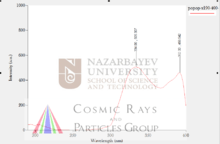POPOP
 | |
| Names | |
|---|---|
| IUPAC name
5-Phenyl-2-[4-(5-phenyl-1,3-oxazol-2-yl)phenyl]-1,3-oxazole | |
| Other names
POPOP | |
| Identifiers | |
| 1806-34-4 | |
| 3D model (Jmol) | Interactive image |
| ChEBI | CHEBI:52236 |
| ChemSpider | 14960 |
| ECHA InfoCard | 100.015.731 |
| EC Number | 217-304-6 |
| PubChem | 15732 |
| |
| |
| Properties | |
| C24H16N2O2 | |
| Molar mass | 364.40 g/mol |
| Except where otherwise noted, data are given for materials in their standard state (at 25 °C [77 °F], 100 kPa). | |
| | |
| Infobox references | |
POPOP or 1,4-bis(5-phenyloxazol-2-yl) benzene is a scintillator. It is used as a wavelength shifter (also called a "secondary scintillator"), which means that it converts shorter wavelength light to longer wavelength light. Its output spectrum peaks at 410 nm, which is violet.[1] POPOP is used in both solid and liquid organic scintillators.
Latest measurements
If one were to search for POPOP, different information can be found.This prompted us at Cosmic Rays and Particle group at Nazarbayev University to actually measure the properties. The POPOP was dissolved in 1,2,4-Trimethylbenzene (PC or pseudocumene) and tested using the Agilent Cary Eclipse spectrophotometer. This is part of the on-going work and once its published, the reference will be provided. Right now, raw plots with watermark are being uploaded so that there is any data available.
Excitation
The POPOP fluorescence is being excited using wavelength from 190nm to 400nm. Fluorescence is monitored at 420nm.

Fluorescence
The fluorescence spectrum is shown. The POPOP being excited at 385nm (near second peak, this is the peak emission of PPO fluor 2,5-Diphenyloxazole). Can clearly observe the emission peak at 420nm.

References
- ↑ Mechanism of Liquid Scintillation Counting, National Diagnostics, retrieved 24 Sept 2007